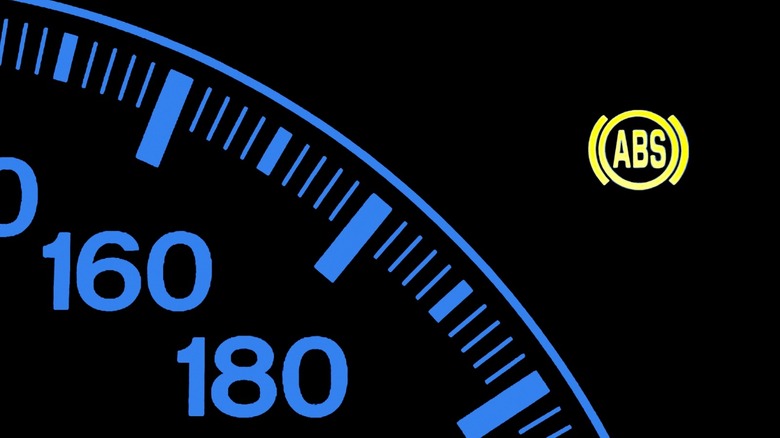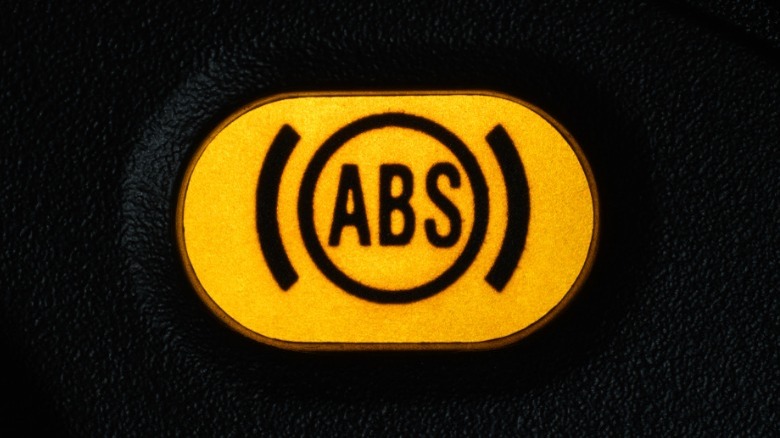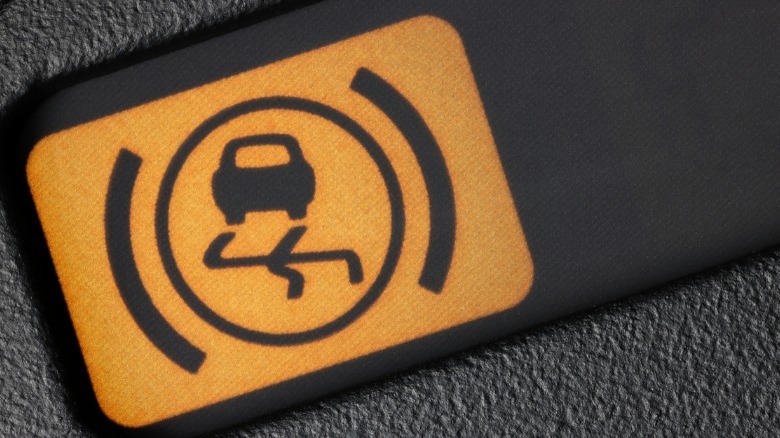What Does ABS Stand For In Cars And What Does It Do?
Modern cars come with a lot of advanced safety features. From basic stuff like a supplemental restraint systems (SRS), which includes airbags and seatbelts, to more state-of-the-art safety equipment like frontal collision and lane departure warnings, our modern vehicles are packed full of technology designed to keep us and our loved ones safe. If we wanted to detail each of the numerous types of safety equipment that you can find on contemporary cars, though, we'd be here all day, and the list would be enormous. However, there are some safety systems that are more common and widespread than others, and it's a good idea to familiarize yourself with some of the most important of those systems.
When it comes to vital vehicle safety equipment, few systems are as important as the ABS or anti-lock braking system. As the name implies, a car's anti-lock braking system works with your vehicle's brakes. It's designed to prevent your wheels from locking up in slippery or unstable driving conditions, but it does a lot more than that and is interconnected with various other vehicle safety systems. Don't worry, though — it's not as confusing as it sounds. As a former professional auto repair technician and a lifelong gearhead, I'll help you understand how ABS works and why it's important. We'll cover all the critical details together, so you can get to know your car better and learn how this vital safety feature works. Let's go ahead and dive in.
What does ABS do?
Your car's ABS is a critical safety feature designed to help you maintain control of the vehicle in unstable driving conditions. While the first car to implement ABS was the Mercedes-Benz S Class back in 1978, ABS didn't become a common feature of mainstream vehicles until the 1980s and '90s. However, since then, ABS has been a standard feature on most new cars, and beginning in 2011, the U.S. federal government issued a mandate requiring all new vehicles to be built with ABS.
But what exactly does ABS do? Anti-lock braking systems work by using a series of wheel speed sensors mounted near your car's wheels. These sensors rely on magnetic fields and work with tone rings or reluctor rings to measure how fast your vehicle's wheels are spinning. If one or more of your wheels stops spinning or starts spinning at a different rate, the sensors will send that data to the ABS control module, which works with the car's computer to selectively apply or reduce brake pressure.
These systems are vital in various driving situations. For example, if you hit a patch of ice or a large puddle of water and begin to skid or hydroplane, your ABS can help you regain control of the vehicle by preventing your wheels from locking up.
Is it safe to drive a car with the ABS light on?
Your car's ABS dashboard warning light should appear briefly when you start the engine. It may also turn on momentarily or flicker when the anti-lock braking system is activated — for example, you may see the ABS light appear quickly on the dash if you hit a patch of black ice or a large puddle of water. However, if your vehicle's ABS warning light turns on and stays on, or if it appears in conjunction with another light, like the brake warning light, then there is most likely a malfunction of some kind.
The ABS light may appear due to various issues, including things like low brake fluid, a blown fuse, worn-out brake pads, damaged sensor wires, a malfunctioning wheel speed sensor, and more. Sometimes, the light may appear for seemingly no reason, and you may be able to reset it by disconnecting your car's battery or using an OBD-II scan tool.
You can drive your vehicle with the ABS light active. However, you should avoid doing so whenever possible. While the light may appear for minor issues, like a blown fuse, it may also turn on for serious problems, like faulty brakes. So, even though it's usually safe to drive short distances with the ABS light lit, you should prioritize visiting a mechanic to diagnose the issue and determine if there are any deeper and more serious problems.
Is ABS the same thing as traction or stability control?
ABS isn't the only vehicle safety system that helps us maintain control in slippery or unstable driving conditions. There are two additional systems that work with the ABS to perform similar functions, and while both of those systems work with the ABS, they are not the same thing.
Traction control systems (TCS) work with your car's ABS to selectively apply or reduce brake pressure to individual wheels if the system detects a loss of traction. Many of these systems can also control engine output, meaning that if a driver begins to lose control in wet or slippery conditions, the TCS will selectively apply brake pressure and reduce engine power until the driver has regained control.
Stability control systems — also known as electronic stability control (ESC), vehicle stability control (VSC), and electronic stability program (ESP) — refer to a more advanced sibling of basic traction control systems. Like TCS, ESC systems work with the ABS to prevent wheel lockup and loss of traction. However, ESC systems go a little further than simply monitoring wheel speed. They also feature steering wheel sensors, yaw speed sensors, and a three-axis accelerometer. ESC systems rely on these sensors to monitor your actual traveling direction and compare it to your intended traveling direction, track how much your wheel's skid or spin, and monitor the vehicle's movement in all directions. ESC systems not only help prevent skidding and loss of control, but also help you maintain control while taking tight turns and performing other quick maneuvers.



